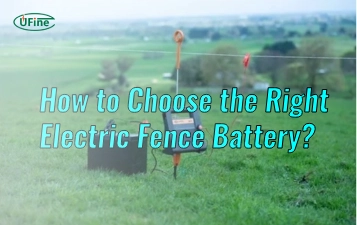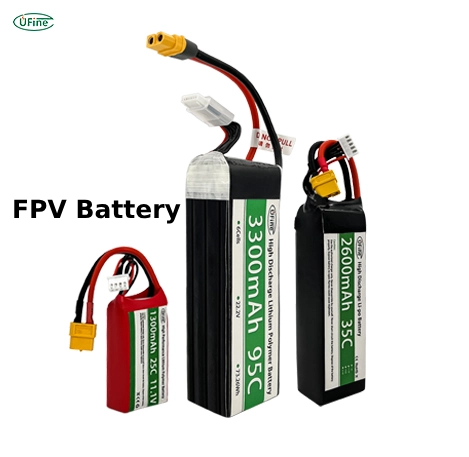FPV batteries power drones, making them fly and perform amazing tricks. This guide will help you understand an FPV battery and the different types available. You will learn about key features, how to choose the right one, and tips for charging and maintaining them. We will also cover common problems and how to solve them.
Part 1. What is an FPV battery?
An FPV battery is a power source for FPV (First Person View) drones. FPV drones use these batteries to fly and operate cameras. The battery provides the energy needed for motors, flight controllers, and other electronics. Here are the critical parts of an FPV battery:
- Cells: FPV batteries consist of cells. Most FPV batteries use lithium polymer (LiPo) cells. Each cell has a voltage, usually 3.7 volts.
- Voltage: The battery’s total voltage depends on the number of cells. For example, a 4S battery has four cells and 14.8 volts (4 x 3.7V).
- Capacity: We measure the capacity of a battery in milliampere-hours (mAh). This tells you how much energy the battery can store. Higher capacity means longer flight time.
- C Rating: The C rating shows how quickly a battery can discharge. A higher C rating means the battery can provide more power quickly, which is suitable for fast and powerful drones.
FPV batteries are crucial for the performance and flight time of your drone. Choosing the correct battery helps ensure a smooth and enjoyable flying experience.
Part 2. Types of FPV batteries
Common Types Used in FPV Drones
FPV drones use several types of batteries. Each type has its benefits and drawbacks. The most common ones are LiPo and Li-ion batteries.
LiPo (Lithium Polymer) Batteries
- High Power Output: LiPo batteries can deliver a lot of power quickly. This makes them great for racing and acrobatic drones.
- Lightweight: They are lighter than many other types of batteries, which helps drones fly faster and longer.
- Flexible Shapes: LiPo batteries can be made in different shapes and sizes, fitting into various drone designs.
- Discharge Rate: They have a high discharge rate (C rating), providing strong and consistent power.
Li-ion (Lithium-Ion) Batteries
- Higher Energy Density: Li-ion batteries store more energy for their size, giving longer flight times.
- Longer Lifespan: They tend to last longer than LiPo batteries, meaning you don’t need to replace them as often.
- Lower Discharge Rate: They have a lower discharge rate, which is suitable for drones that do not need high bursts of power.
- Safety: Li-ion batteries are generally safer and less likely to catch fire than LiPo batteries.
Comparison of Different Battery Types
When choosing between LiPo and Li-ion batteries, consider the following:
- Flight Time: Li-ion batteries usually offer longer flight times because of their higher energy density.
- Power Needs: LiPo batteries are better if your drone requires high power for quick maneuvers.
- Weight: LiPo batteries are lighter, which can improve your drone’s performance.
- Safety: Li-ion batteries are safer and less prone to overheating and catching fire.
- Cost: Li-ion batteries can be more expensive, but they also last longer, potentially saving money over time.
Part 3. Critical features of FPV batteries
Voltage
Voltage is a crucial feature of FPV batteries. It determines how much power the battery can provide to your drone. Most FPV batteries are rated as 1S, 2S, 3S, 4S, 5S, or 6S:
- 1S: Single cell, 3.7V
- 2S: Two cells, 7.4V
- 3S: Three cells, 11.1V
- 4S: Four cells, 14.8V
- 5S: Five cells, 18.5V
- 6S: Six cells, 22.2V
Higher voltage means more power, faster speeds, and more stress on the drone’s components.
Capacity
We measure capacity in milliampere-hours (mAh). It shows how much energy the battery can store. Higher capacity batteries allow for longer flight times. For example:
- 1000mAh: Shorter flight time, lighter weight
- 1500mAh: Balanced flight time and weight
- 2000mAh and above: Longer flight time, heavier weight
Choosing the suitable capacity depends on the balance between flight duration and the weight your drone can handle.
Discharge Rate (C Rating)
The discharge rate, or C rating, indicates how quickly a battery can deliver power. A higher C rating means the battery can provide more power quickly. Here are some typical C ratings:
- 20C to 30C: Suitable for casual flying
- 30C to 60C: Good for racing and acrobatic drones
- 60C and above: Best for high-performance drones
Higher C ratings are excellent for powerful flights but can drain the battery faster.
Connectors
Connectors link the battery to your drone. Common types include:
- XT60: Popular and reliable, used in many FPV drones
- XT30: Smaller version of XT60, for lighter and smaller drones
- Dean T-Plug: Older but still in use, good for medium-power drones
- EC3/EC5: Used in some specific brands, stable and efficient
Choosing the right connector ensures compatibility and stable power delivery.
Weight
Weight is significant because it affects your drone’s performance. Heavier batteries can reduce maneuverability and speed. Compare the weight of different batteries to find the best one for your drone’s needs.
Size and Shape
FPV batteries come in various sizes and shapes. Make sure the battery fits your drone’s battery compartment. Measure available space and choose a battery that fits snugly without being too tight.
Safety Features
Safety is crucial when dealing with high-power batteries. Look for features like:
- Overcharge protection: Prevents damage from charging too much
- Short circuit protection: Stops the battery from damage if there’s a short circuit
- Temperature monitoring: Helps avoid overheating during use or charging
These features help keep your drone and its battery safe during operation.
Part 4. Choosing the correct FPV battery
Choosing the correct FPV battery is crucial for optimizing your drone’s performance and longevity. Here’s a detailed guide on how to make the best choice:
- Voltage and Cell Count: Determine the voltage based on your drone’s specifications. Higher voltages provide more power but require compatible components.
- Capacity (mAh): Consider your flight needs. Higher capacity batteries offer longer flight times but may be heavier.
- Discharge Rate (C Rating): Match the C rating to your drone’s power requirements. Higher C ratings provide more burst power for maneuvers.
- Size and Weight: Ensure the battery fits your drone’s compartment and doesn’t compromise its balance or agility.
- Connector Type: Choose a connector (like XT60 or XT30) that matches your drone’s power system for efficient power transfer.
- Budget: Balance performance with cost. Higher-quality batteries often offer better performance and longevity.
- Brand and Reputation: Opt for reputable brands known for reliability and safety in FPV batteries.
Part 5. Charging and maintaining FPV batteries
Properly charging and maintaining FPV batteries is essential for safety and longevity. Follow these guidelines:
- Charging: Use a balanced charger designed for LiPo batteries. Set the correct voltage and cell count to avoid overcharging or undercharging.
- Storage: Store batteries at 3.7V per cell (storage voltage) in a fireproof container. Avoid storing fully charged or fully depleted batteries.
- Temperature: Charge and use batteries in a relaxed, dry environment. Avoid exposure to extreme temperatures.
- Inspect Regularly: Check batteries for damage or swelling before and after flights. Dispose of damaged batteries safely.
- Cycle Batteries: Occasionally discharge and recharge batteries to maintain health and performance.
- Transportation: Use a proper storage bag or case to prevent short circuits or damage when transporting batteries.
Part 6. Common issues with FPV batteries and solutions
FPV batteries can encounter several common issues that affect performance and longevity. Here are some detailed explanations and solutions for these issues:
Swelling or Puffing
- Issue: Batteries may swell or puff due to overcharging, excessive discharging, or physical damage.
- Solution: Replace swollen batteries immediately to prevent potential hazards. Ensure proper charging and storage practices to avoid over-discharging or overcharging.
Voltage Sag Under Load
- Issue: Voltage sag occurs when the battery cannot maintain its voltage under high current loads, leading to reduced performance and flight time.
- Solution: Choose batteries with a higher C rating to handle higher current demands. Ensure the battery is fully charged before flight and monitor voltage during use.
Reduced Flight Time
- Issue: Batteries may lose capacity and provide shorter flight times than expected.
- Solution: Rotate batteries regularly to prevent overuse of any single battery—charge, and store batteries at the correct voltage to maintain longevity.
Connector Issues
- Issue: Connectors may become loose, damaged, or incompatible with your drone or charger.
- Solution: Inspect connectors before each use and replace damaged connectors promptly. Use connectors that match your drone’s power system for optimal performance.
Overheating
- Issue: Batteries can overheat during charging, discharging, or use, which may lead to performance degradation or safety risks.
- Solution: Charge batteries in a cool, well-ventilated area away from flammable materials. Avoid rapid charging and monitor battery temperature during use.
Storage Problems
- Issue: Incorrect storage practices can lead to battery degradation or safety hazards.
- Solution: Store batteries at a storage charge (around 3.7V per cell) in a fireproof container. Avoid storing batteries fully charged or fully depleted for extended periods.
Safety Concerns
- Issue: Mishandling or misusing FPV batteries can result in fires or other safety hazards.
- Solution: Follow manufacturer guidelines for charging, handling, and disposing batteries. Use fireproof charging bags or containers for added safety.
Part 7. FAQs
-
Can I use any battery for my FPV drone?
FPV drones require specific batteries like LiPo or Li-ion due to their power and discharge characteristics. Using the wrong type can affect performance and safety. -
How do I know when my FPV battery has reached full charge?
Use a balanced charger that indicates when the battery reaches its total capacity. Avoid overcharging, which can damage the battery. -
What should I do if my FPV battery starts to swell?
To prevent safety risks, drone operators should immediately replace swollen batteries. Ensure proper charging and storage practices to avoid swelling. -
How often should I replace my FPV batteries?
It depends on usage and care. Generally, FPV batteries last for around 200-300 charge cycles. Replace them if you notice reduced flight time or swelling. -
Can I store my FPV batteries in the refrigerator?
No, storing batteries in a refrigerator can cause moisture damage. Store them in a cool, dry place at a storage charge level (around 3.7V per cell) in a fireproof container.
Related Tags:
More Articles

How to Choose the Right Electric Fence Battery?
Choosing the right electric fence battery is key to security. This guide helps you pick a reliable farm, garden, or animal power source.
What Are Lithium Pouch Cells?
Explore how lithium pouch cells work, their structure, advantages, and uses. Learn from a trusted supplier like Ufine Battery for custom lithium solutions.
The Evolution of Ring Battery Pack Technology in Lithium Battery Manufacturing
Ring battery packs are reshaping lithium battery tech. Discover their evolution, key uses, and why they matter for the future of energy storage.
Lithium vs Lithium Salt: What’s the Difference?
Lithium is a pure metal, while lithium salts are stable battery compounds. Learn their key roles and differences in battery manufacturing.
What You Need to Know About AA 3.6V Lithium Battery
Learn all about AA 3.6V lithium batteries—voltage, size, capacity, uses, and the best replacements. Discover why they’re powerful, and highly reliable.




